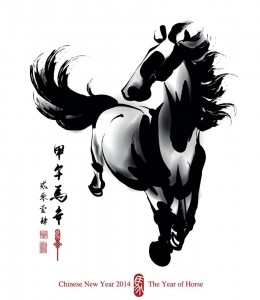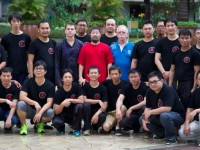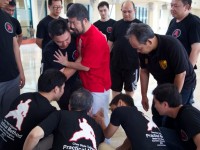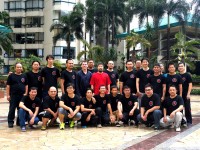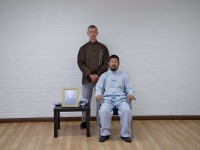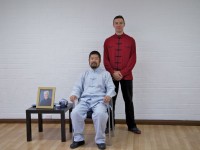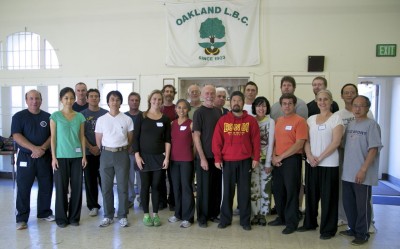This is the requirement of the erected calf. In many styles of martial art, this concept is referred to as zhuang, pile, stake or zhan zhuang.
Chen Zhonghua Taiji Academy
Tossing is action without rotation or without an axis.
Rotation is the key characteristic of Chen Style Taijiquan Practical Method. It sets this art apart from other arts. There are no natural rotations in human movements. They are made up as a result of specialized training in the Chen Style Taijiquan Practical Method system.
This is the hand-elbow relationship. This method ensures that the hand and elbow are connected on a line so as to be useful in conducting energy.
This is the “ten character dictum” by Grandmaster Hong Junsheng. Read more
This is the vertical alignment for the third vertical line. The kua acts as a socket for the shoulder. The shoulder does not physically sit inside the kua but must always be sitting in the kua remotely in terms of position and direction.
This concept is similar to the idea that what driving downhill, don’t put your car into neutral. Power must be constant and consistent in all taiji movements.
By following this principle of Chen Style Taijiquan Practical Method, our taiji actions will be different from normal human movements. We therefore, no longer “move” (Don’t move!). We become the other “Kind”. Read more
Inside and outside is a set of yin and yang. This principle refers to the movements in this set of yin yang separation. Read more
The outside must always be stronger than the inside like a bomb and an egg. The shells are considered outside. The reference to stronger or not of the outside and inside refers only to the physical property.
Don’t move! Don’t move your hands! Don’t move your torso! Don’t move your body! Don’t move your center! Don’t move your knee! Don’t move your feet! Read more
This is another special characteristic and principle of the Chen Style Taijiquan Practical Method. First raised by GM Hong Junsheng.
Sit the wrist is a special term used in Chen Style Taijiquan Practical Method. It means that the wrist must be stretched open into a curved position and then locked into place. This is also part of the Tile Hand requirement.
The classic mention of this term is “understanding the three joints” (明三节). Read more
“the inside stays on the inside and the outside stays on the outside” is a major taiji principle. The five heads are considered outside; everything else is considered inside.
Range of motion refers to the ability to move and the extent of movements in taijiquan. It is NOT the same as flexibility. Read more
There are two types of movements in Chen Style Taijiquan Practical Method.
- Primary movements.
- Secondary movements. Read more
The kua must be higher than the knee. This ensures that the lower body stance remains an bridge arch. If the kua is lower than the knee, then this arch is reversed.
In transitional and extreme cases, this principle is temporarily violated.
Zhou Bu Li Lei. 肘不离肋。
The elbow can move past the centerline of the body. It can also go down and go inwards. It cannot move upwards or outwards.
This means that the left hand must only be allowed to move in the left side of the torso. The right hand is only allowed to move in the right side of the torso. The demarcation line is the centerline of the chest.
Chen style Taijiquan Practical Method class starting at the Balmain PCYC on Monday evening from 7pm to 8:30pm
Address: 372 Darling St, Balmain NSW 2041
Contact: Paul Janssens at info@chenpracticalmethod.com.au
Michael Calandra will be teaching a workshop on Practical Method in London on the 21-22 of November. Anyone interested can contact Asad Habib via facebook , or email Michael Calandra at oikddojo@aol.com.
http://www.seishinkanonline.com/
- Left hand
- Right hand
- Left foot
- Right foot
- Head
These are considered the five points of the outside of the body. Everything else is considered the inside of the body.
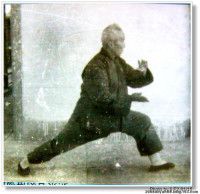 It is considered a good thing to hurt the muscles. Muscles are not afraid of pain. In the Practical Method system, we do not train the muscles. Train muscles means to bulk up the muscles to make them strong. We elongate muscles. This requires a different method of training.
It is considered a good thing to hurt the muscles. Muscles are not afraid of pain. In the Practical Method system, we do not train the muscles. Train muscles means to bulk up the muscles to make them strong. We elongate muscles. This requires a different method of training.
It is a bad thing to hurt ligaments and bones. Ligaments and bones are afraid of being shortened, not elongated. Postures should be large and low so as to allow the elongation of ligaments and the skeletal structure.
[wowslider id=”41″] Read more
Oakland Lawn Bowling Club. Nathan and I went to check the hall before and seminar and pushed hands outside in the park for about an hour.
[wowslider id=”40″]
Iowa Workshop on October 12, 2013.
- The body is not ready as any material.
- The body is ready for something else, not taiji material.
[wowslider id=”32″]

-1024x512.jpg)

